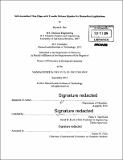Self-assembled thin films with tunable release kinetics for biomedical applications
Author(s)
Hsu, Bryan Boen
DownloadFull printable version (20.35Mb)
Other Contributors
Massachusetts Institute of Technology. Department of Chemistry.
Advisor
Paula T. Hammond.
Terms of use
Metadata
Show full item recordAbstract
The appropriate drug delivery approach is critical to therapeutic success without causing serious harm. Systemic delivery is a common method for delivering drugs but high dosages are needed to maintain elevated plasma levels, which can increase the risk of adverse drug reactions. Locally delivering these drugs offers an interesting alternative by significantly reducing the necessary dosages for therapeutic effect. Unfortunately, controlled delivery strategies can be limited with regards to the types of drugs as well as their release kinetics, especially if more than one drug is involved. Furthermore, for implantable devices biocompatibility and biodegradability are important considerations for minimizing undesirable side effects. This thesis utilizes the layer-by-layer (LbL) approach for the construction of biodegradable thin films that are capable of controlling the kinetics of localized drug delivery. Typically, controlling the release profiles of more than one drug is difficult, especially from a single film or device. To treat especially recalcitrant diseases, it is sometimes necessary to utilize complex or multimodal drug release behavior for positive therapeutic outcome. We first examined the use a naturally-derived, hydrolytically-degradable polyanion, poly(P-L-malic acid) (PMLA), for use in LbL films to control the rate of film erosion and hence protein elution which was tuned from minutes to weeks depending on the film's architecture. We further adapted the film architecture with subtle chemical modifications for sequential protein release without significant overlap and staged release where a rapid hemostat release coincided with sustained antibiotic release for more than 24 hours. We also examined a biodegradable thin film formulation capable of long-term (14+ months) elution of an active small molecule drug. For rapid hemostasis, it is sometimes difficult to achieve without use of sensitive biologics that require constant refrigeration and so we utilized films composed of self-assembling peptide nanofibers, which we found to be extremely robust and rapidly capable of forming nanofiber based clots despite prolonged incubation in elevated temperatures (2 months at 60°C). Overall this work expands on the controlled release repertoire by investigating fundamental aspects as well as translational applications.
Description
Thesis: Ph. D. in Biological Chemistry, Massachusetts Institute of Technology, Department of Chemistry, 2014. Cataloged from PDF version of thesis. Vita. Includes bibliographical references.
Date issued
2014Department
Massachusetts Institute of Technology. Department of ChemistryPublisher
Massachusetts Institute of Technology
Keywords
Chemistry.